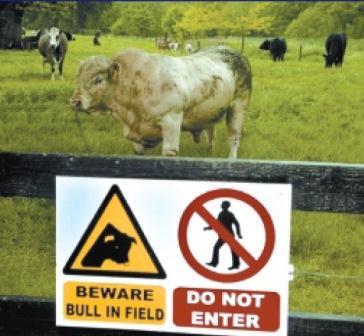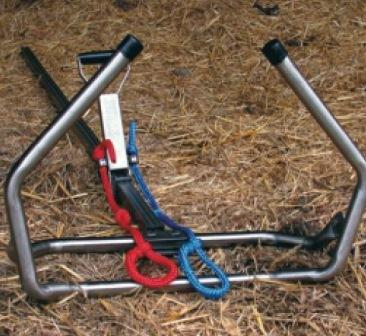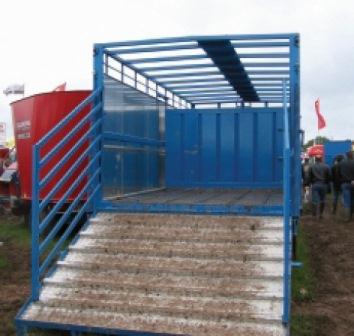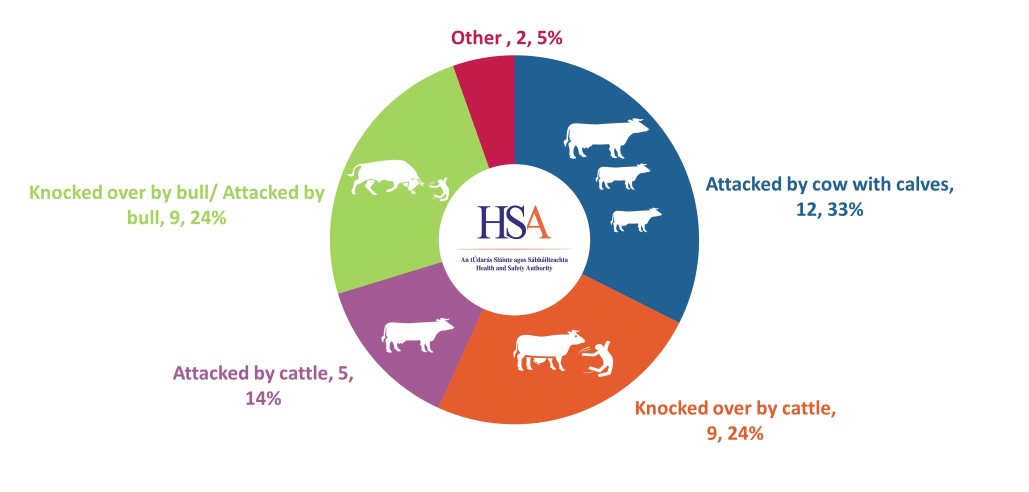Working with Cattle
Livestock precautions
- Good handling facilities are essential when handling cattle and other livestock.
- A proper crush is a must for safe livestock handling
- Use a well designed calving gate when calving cows
- Many serious farming accidents occur when loading and unloading livestock
- Provide suitable facilities for loading and unloading animals
- All bulls are potentially dangerous. Always, fit a ring and chain to a stock bull when it is out in the field and exercise great caution if you need to enter the field with the bull
- If entering the field or herding always use a tractor or suitable farm vehicle as a mobile sanctuary from the bull
|  |
- Animals react unpredictably when they are handled by an unfamiliar person, are in unfamiliar surroundings, and when they are separated from a familiar group
- Animals respond to the way they are treated and draw upon past experiences when reacting to a situation.
Back to top
Handling facilities
Handling facilities play a major role in preventing injury. - The race and crush should be placed where stock can be assembled easily
- Having handling facilities at out-farms or locations remote from the farmyard reduces unnecessary movement of stock
- Well-designed handling facilities reduce the risk of injury involving livestock. Specifications for livestock handling and housing facilities are available from the website of the Department of Agriculture, Food and the Marine
- Never enter the crush with livestock, since crushing, particularly of the chest, can cause serious injury or death
- Wear boots with steel toe-caps to help prevent foot injuries
|  |
Back to top
Bulls
In this video, James talks about the loss of his father to a bull attack (5 minutes, 47 seconds).
- Bulls must always be treated with caution. Even seemingly placid bulls are unpredictable, so care is essential at all times
- Bull handlers should be aged between 18 and 65, and be fit, agile and properly trained
How should a bull be handled?- From an early age, the bull should learn to associate the presence of people with pleasant things such as feeding, grooming and exercise
- All bulls should be ringed when 10 months old, and the ring should be examined regularly
- Consider having an aggressive bull slaughtered
- When grazing a bull with the herd, make maximum use of fields where the public do not have access
- Any field in which a bull is kept should be securely fenced and gates safely secured and maintained
|  |
- It is recommended that a strong chain which touches the ground should be fitted
- A tractor or suitable farm vehicle should always be provided as a mobile sanctuary
- Young children should not be allowed into a field where a bull is running
- A safety sign warning of a bull's presence should be displayed adjacent to public places, particularly at access pointsA well-designed bull pen is essential for managing a bull when it is away from the herd. The design should allow the stockman to feed and bed the bull without entering the pen
- A bull pen should be located where the bull can see other animals. On dairy farms the pen should be located where the bull can see cows going to and from the parlour or paddocks
|  |
Back to top
Calving and weaning
Cows, and in particular heifers, can be unpredictable during or after calving. After calving, a cow may become aggressive towards any intruder in her space.Cows have attacked and killed farmers.
In this video, Dominic talks about the impact on him and his family following a cow attack (5 minutes, 17 seconds)
Work practices such as taking a newborn calf from a cow, hand-milking or introducing a strange calf can provoke a sudden change of behaviour. Generally, but not always, pre-calving warning signs occur, such as nervousness and excitement. This means that caution is required.
- The calving area should have adequate space and be well bedded. It should be tidy and free from obstructions and have good lighting
- Properly used calving jacks can reduce the possibility of back injury
- Many farmers injure themselves while lifting and swinging new-born calves to revive them. Basic mechanical lifting aids, such as a pulley system in the calving pen, can prevent a back injury
- Keep the calf between you and the heifer or cow and have an escape route planned. Do not turn your back on the cow
- Keep children away from the calving area. A dog in or near the calving area is likely to upset cows
|  |
Back to top
Loading and unloading
Animals being transported or moved can become stressed and may react unpredictably and cause injury. - Loading and unloading facilities should be designed to streamline the process. This is best achieved by having a door or gate to the assembly area that matches the width of the livestock trailer
- A crush can be used to load animals safely
- Make sure there are adequate ramp gates on a livestock trailer, otherwise livestock may charge the tail door and
cause serious injury
|  |
Back to top
Livestock Fatalities
Bull attacks accounted for a lot of livestock deaths. In this video, James talks about the loss of his father in a bull attack (5 minutes, 47 seconds). However, all livestock present a risk. Being crushed or gored by animals (particularly bulls) that are being herded, moved, separated, released or loaded onto trailers presents the highest risk. Cows with new-born young pose a significant risk.
Teagasc research indicates that 65%of all farm injuries are livestock related. Many of these accidents involve cattle (bulls, cows and bullocks) and occur when animals are being herded in fields or handled by farmers in farmyards or farm buildings. The increase in livestock related accidents and deaths are attributable to inadequate handling facilities on farms, poor set up or taking risks when dealing with livestock, less contact between farmer and livestock and inadequate attention given to breeding animals for docility.
Prevention will be achieved by focusing on the handling facilities on the farm, the type of livestock and on the behaviour of the person working with the livestock.
Work-related fatalities involving livestock 2014 - 2023

In this video, James talks about the loss of his father in a bull attack (5 minutes, 47 seconds). In this video, Dominic talks about the impact on him and his family following a cow attack (5 minutes, 17 seconds).
Back to top
For Further Information
Survivor Stories - a series of videos, where real farmers talk about accidents and the effects on their families and friends. Viewer discretion is advised.
Department of Agriculture, Food and the Marine
Back to top